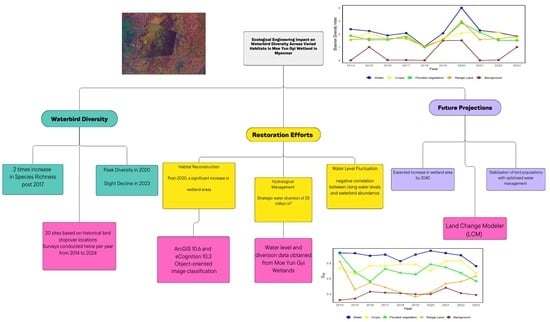Modeling the Impact of Ecological Restoration on Waterbird Diversity and Habitat Quality in Myanmar’s Moe Yun Gyi Wetland
Simple Summary
Abstract
1. Introduction
2. Materials and Methods
2.1. Study Area
2.2. Habitat Landscape in Remote Sensing Interpretation
2.3. Bird Survey Methods
2.4. Data Analysis
- H’ = Species Diversity
- Pi = the proportional of individuals found in the ith species
- ln = the natural logarithm
- H’ between 1.5 and 3.5 is found in natural communities.
2.5. A Methodological Approach for 2030 and 2040 Projections
3. Results
3.1. Habitat Area Changes
3.2. Changes in Waterbird Metrics in Different Habitats
3.3. Waterbird Species and Population Changes in Water Metrics
3.4. Changes in Rare Waterbird Species and Numbers in the Region
3.5. Dynamic Changes in Habitats, Waterbird Abundances, and Diversity Indices from 2030 to 2040
4. Discussion
4.1. Ecological Conditions and Habitat-Specific Factors
4.2. Waterbird Species, Abundances and Indices
4.3. Fluctuations in the Population of Rare Species
4.4. Discussion on Habitat Area Changes and Their Ecological Implications from 2010 to 2040
5. Conclusions
Author Contributions
Funding
Institutional Review Board Statement
Informed Consent Statement
Data Availability Statement
Acknowledgments
Conflicts of Interest
References
- Zhang, S.; Zhang, P.; Pan, B.; Zou, Y.; Xie, Y.; Zhu, F.; Chen, X.; Li, F.; Deng, Z.; Zhang, H.; et al. Wetland Restoration in the East Dongting Lake Effectively Increased Waterbird Diversity by Improving Habitat Quality. Glob. Ecol. Conserv. 2021, 27, e01535. [Google Scholar] [CrossRef]
- Xu, X.; Chen, M.; Yang, G.; Jiang, B.; Zhang, J. Wetland Ecosystem Services Research: A Critical Review. Glob. Ecol. Conserv. 2020, 22, e01027. [Google Scholar] [CrossRef]
- Andreychev, A.; Kuznetsov, V.; Lapshin, A. Distribution and Population Density of the Russian Desman (Desmana moschata L., Talpidae, Insectivora) in the Middle Volga of Russia. For. Stud. 2019, 71, 48–68. [Google Scholar] [CrossRef]
- Cao, Y.; Wang, S.; Tian, G.; Dong, N.; Lei, Y. Coupling Biodiversity and Human Pressures to Indicate Conservation Priorities for Threatened Waterfowl Species: A Case in the Henan Yellow River Wetland National Nature Reserve. Land 2023, 12, 1250. [Google Scholar] [CrossRef]
- Sun, C.; Zhen, L.; Wang, C.; Yan, B.; Cao, X.; Wu, R. Impacts of Ecological Restoration and Human Activities on Habitat of Overwintering Migratory Birds in the Wetland of Poyang Lake, Jiangxi Province, China. J. Mt. Sci. 2015, 12, 1302–1314. [Google Scholar] [CrossRef]
- Aung, T.D.W.; Kyi, S.W.; Suzue, K.; Theint, S.M.; Tsujita, K.; Yu, T.T.; Merriman, J.C.; Peh, K.S.-H. Rapid Ecosystem Service Assessment of a Protected Wetland in Myanmar, and Implications for Policy Development and Management. Ecosyst. Serv. 2021, 50, 101336. [Google Scholar] [CrossRef]
- Muñoz-Pedreros, A.; Merino, C. Diversity of Aquatic Bird Species in a Wetland Complex in Southern Chile. J. Nat. Hist. 2014, 48, 1453–1465. [Google Scholar] [CrossRef]
- Li, X.; Anderson, C.J.; Wang, Y.; Lei, G. Waterbird Diversity and Abundance in Response to Variations in Climate in the Liaohe Estuary, China. Ecol. Indic. 2021, 132, 108286. [Google Scholar] [CrossRef]
- Li, D.; Zhu, S.; Gao, J.; Jiang, H.; Deng, G.; Sheng, L.; Cao, Y.; Li, L.; Lin, B. The Influence of Ecological Engineering on Waterbird Diversity in Different Habitats within the Xianghai Nature Reserve. Diversity 2022, 14, 1016. [Google Scholar] [CrossRef]
- Li, D.; Chen, S.; Guan, L.; Lloyd, H.; Liu, Y.; Lv, J.; Zhang, Z. Patterns of Waterbird Community Composition across a Natural and Restored Wetland Landscape Mosaic, Yellow River Delta, China. Estuar. Coast. Shelf Sci. 2011, 91, 325–332. [Google Scholar] [CrossRef]
- Wang, X.; Chen, J.; Zhou, L. Effects of Human Activities on the Diversity of Waterbirds Wintering in a Shallow Lake of the Middle and Lower Yangtze River Floodplain, China. Diversity 2020, 12, 302. [Google Scholar] [CrossRef]
- Zhang, C.; Yuan, Y.; Zeng, G.; Liang, J.; Guo, S.; Huang, L.; Hua, S.; Wu, H.; Zhu, Y.; An, H.; et al. Influence of Hydrological Regime and Climatic Factor on Waterbird Abundance in Dongting Lake Wetland, China: Implications for Biological Conservation. Ecol. Eng. 2016, 90, 473–481. [Google Scholar] [CrossRef]
- Taft, O.W.; Colwell, M.A.; Isola, C.R.; Safran, R.J. Waterbird Responses to Experimental Drawdown: Implications for the Multispecies Management of Wetland Mosaics. J. Appl. Ecol. 2002, 39, 987–1001. [Google Scholar] [CrossRef]
- Elafri, A.; Belhamra, M.; Houhamdi, M. Comparing Habitat Preferences of a Set of Waterbird Species Wintering in Coastal Wetlands of North Africa: Implication for Management. Ekológia 2017, 36, 158–171. [Google Scholar] [CrossRef]
- Liu, Y.; Ji, X.; Zhou, L. Assessment of Waterbird Habitat Importance and Identification of Conservation Gaps in Anhui Province. Animals 2024, 14, 1004. [Google Scholar] [CrossRef]
- Faragó, S.; Hangya, K. Effects of Water Level on Waterbird Abundance and Diversity along the Middle Section of the Danube River. Hydrobiologia 2012, 697, 15–21. [Google Scholar] [CrossRef]
- Li, X.; Zeng, Q.; Lei, G.; Sun, G. Effects of Meteorological Factors on Waterbird Functional Diversity and Community Composition in Liaohe Estuary, China. Int. J. Environ. Res. Public Health 2022, 19, 5392. [Google Scholar] [CrossRef]
- Kirby, J.S.; Stattersfield, A.J.; Butchart, S.H.M.; Evans, M.I.; Grimmett, R.F.A.; Jones, V.R.; O’Sullivan, J.; Tucker, G.M.; Newton, I. Key Conservation Issues for Migratory Land- and Waterbird Species on the World’s Major Flyways. Bird Conserv. Int. 2008, 18, S49–S73. [Google Scholar] [CrossRef]
- Bolam, F.C.; Ahumada, J.; Akçakaya, H.R.; Brooks, T.M.; Elliott, W.; Hoban, S.; Mair, L.; Mallon, D.; McGowan, P.J.; Raimondo, D.; et al. Over Half of Threatened Species Require Targeted Recovery Actions to Avert Human-induced Extinction. Front. Ecol Environ. 2023, 21, 64–70. [Google Scholar] [CrossRef]
- Akçakaya, H.R.; Bennett, E.L.; Brooks, T.M.; Grace, M.K.; Heath, A.; Hedges, S.; Hilton-Taylor, C.; Hoffmann, M.; Keith, D.A.; Long, B.; et al. Quantifying Species Recovery and Conservation Success to Develop an IUCN Green List of Species. Conserv. Biol. 2018, 32, 1128–1138. [Google Scholar] [CrossRef]
- Zhu, Y.; Wang, H.; Guo, W. The Impacts of Water Level Fluctuations of East Dongting Lake on Habitat Suitability of Migratory Birds. Ecol. Indic. 2021, 132, 108277. [Google Scholar] [CrossRef]
- Sun, C.; König, H.J.; Uthes, S.; Chen, C.; Li, P.; Hemminger, K. Protection Effect of Overwintering Water Bird Habitat and Defining the Conservation Priority Area in Poyang Lake Wetland, China. Environ. Res. Lett. 2020, 15, 125013. [Google Scholar] [CrossRef]
- Finlayson, C.M.; Rastogi, G.; Mishra, D.R.; Pattnaik, A.K. Ecology, Conservation, and Restoration of Chilika Lagoon, India; Springer: Berlin/Heidelberg, Germany, 2020; ISBN 3-030-33423-6. [Google Scholar]
- DeGange, A.R.; Marcot, B.G.; Lawler, J.; Jorgenson, T.; Winfree, R. Predicting the Effects of Climate Change on Ecosystems and Wildlife Habitat in Northwest Alaska: Results from the WildCast Project. Alsk. Park Sci. 2014, 12, 66–73. [Google Scholar]
- Roy, S.K.; Alam, M.T.; Mojumder, P.; Mondal, I.; Kafy, A.-A.; Dutta, M.; Ferdous, M.N.; Al Mamun, M.A.; Mahtab, S.B. Dynamic Assessment and Prediction of Land Use Alterations Influence on Ecosystem Service Value: A Pathway to Environmental Sustainability. Environ. Sustain. Indic. 2024, 21, 100319. [Google Scholar] [CrossRef]
- Wang, C.; Wang, G.; Dai, L.; Liu, H.; Li, Y.; Qiu, C.; Zhou, Y.; Chen, H.; Dong, B.; Zhao, Y.; et al. Study on the Effect of Habitat Function Change on Waterbird Diversity and Guilds in Yancheng Coastal Wetlands Based on Structure–Function Coupling. Ecol. Indic. 2021, 122, 107223. [Google Scholar] [CrossRef]
- Brander, L.; Brouwer, R.; Wagtendonk, A. Economic Valuation of Regulating Services Provided by Wetlands in Agricultural Landscapes: A Meta-Analysis. Ecol. Eng. 2013, 56, 89–96. [Google Scholar] [CrossRef]
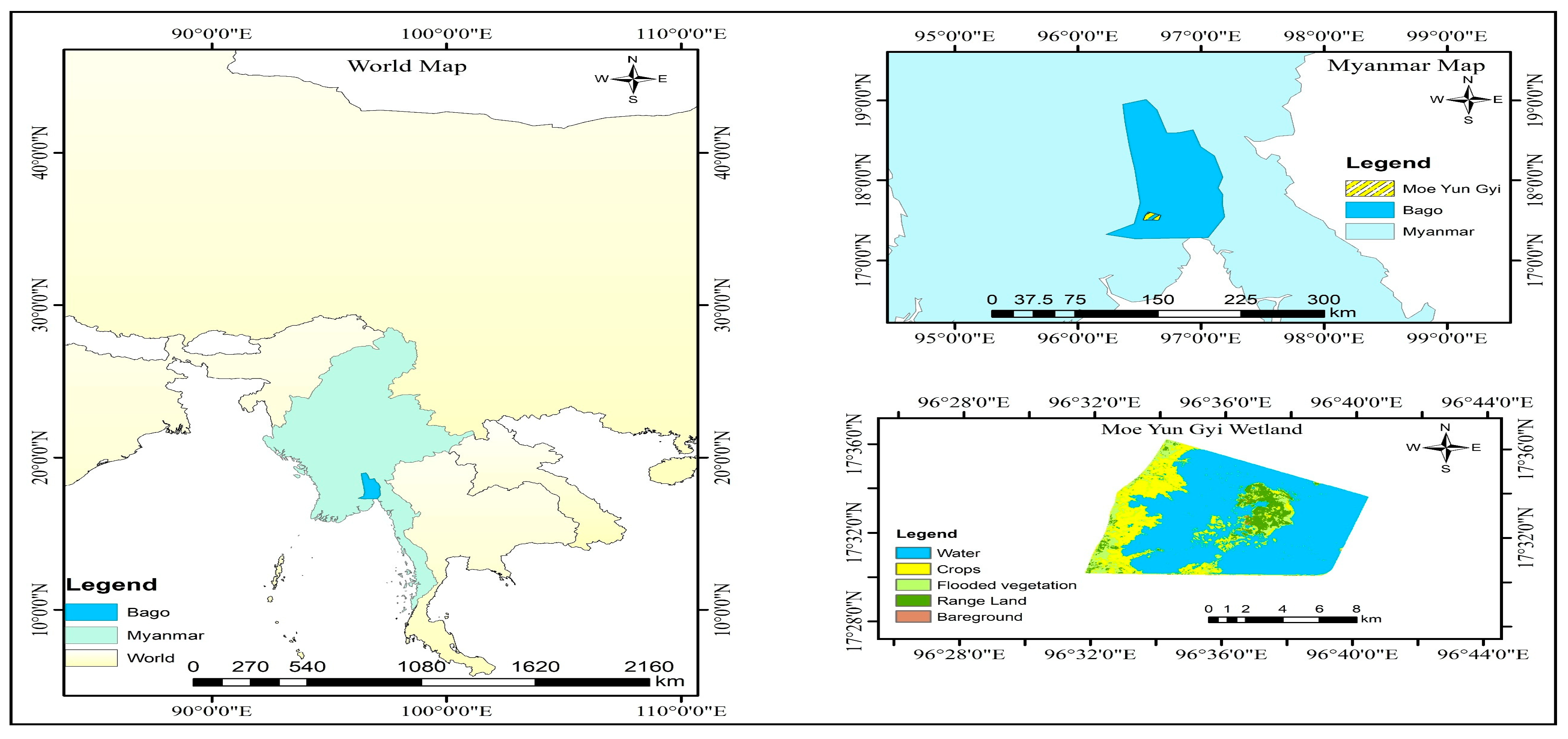
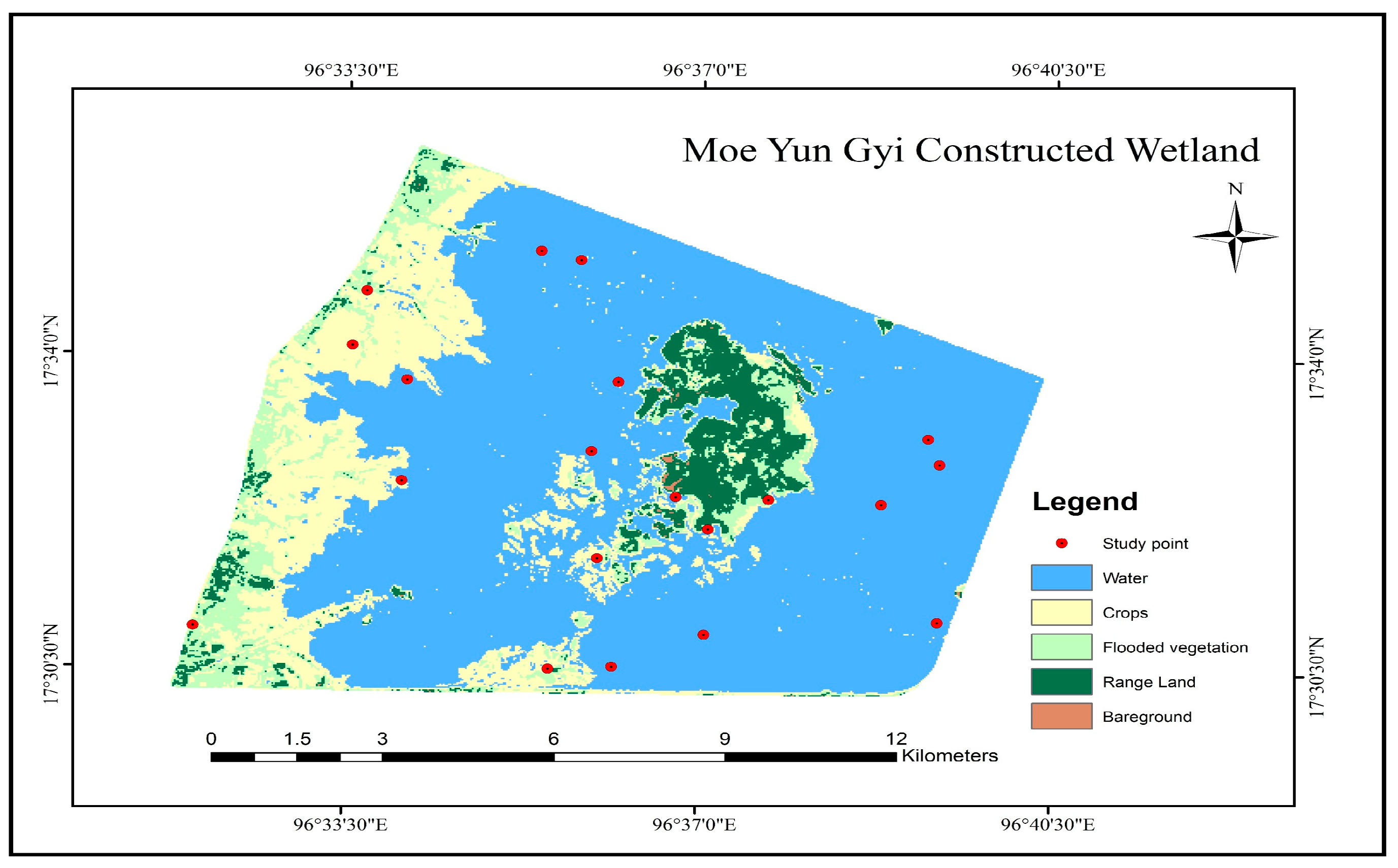
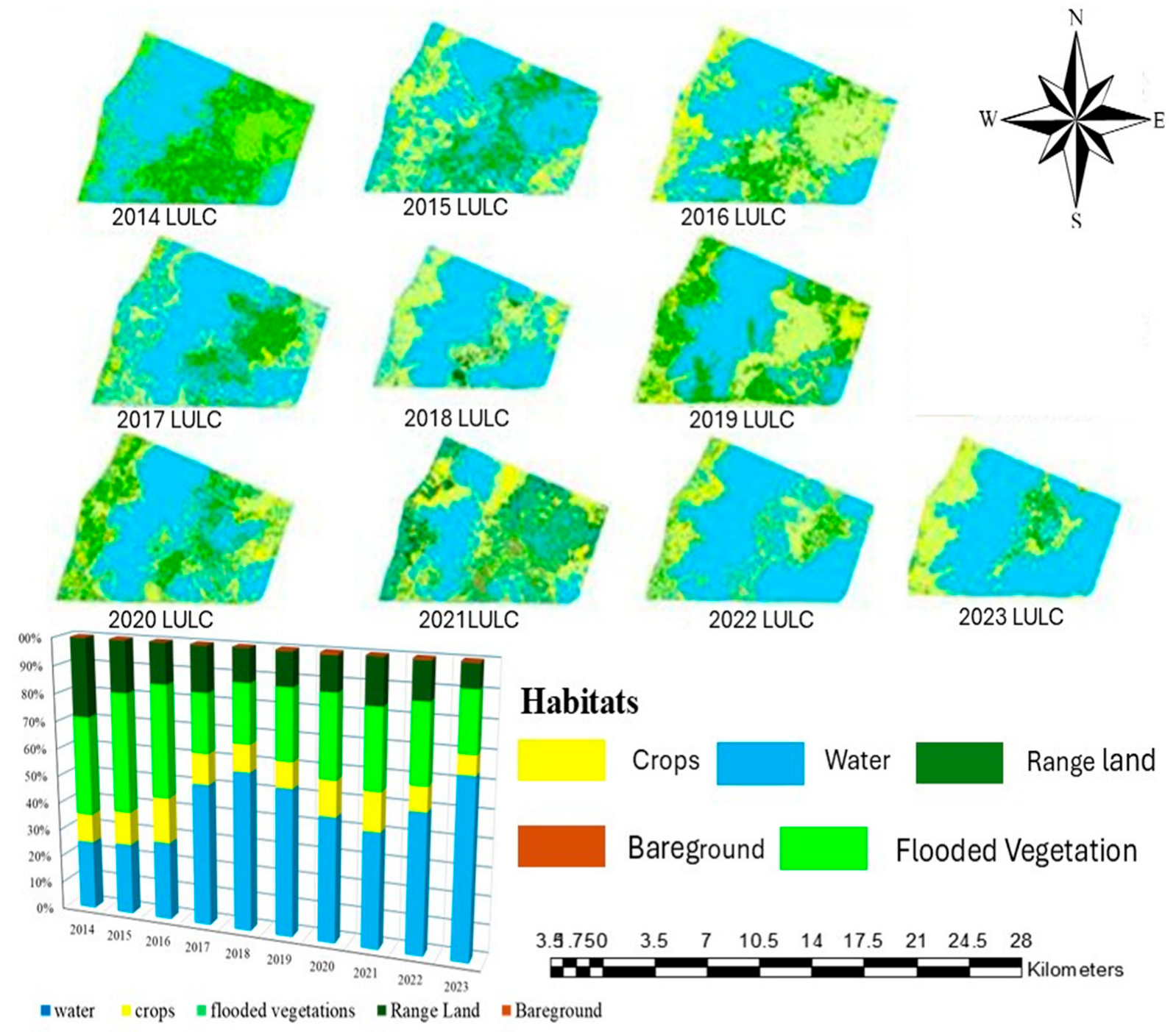
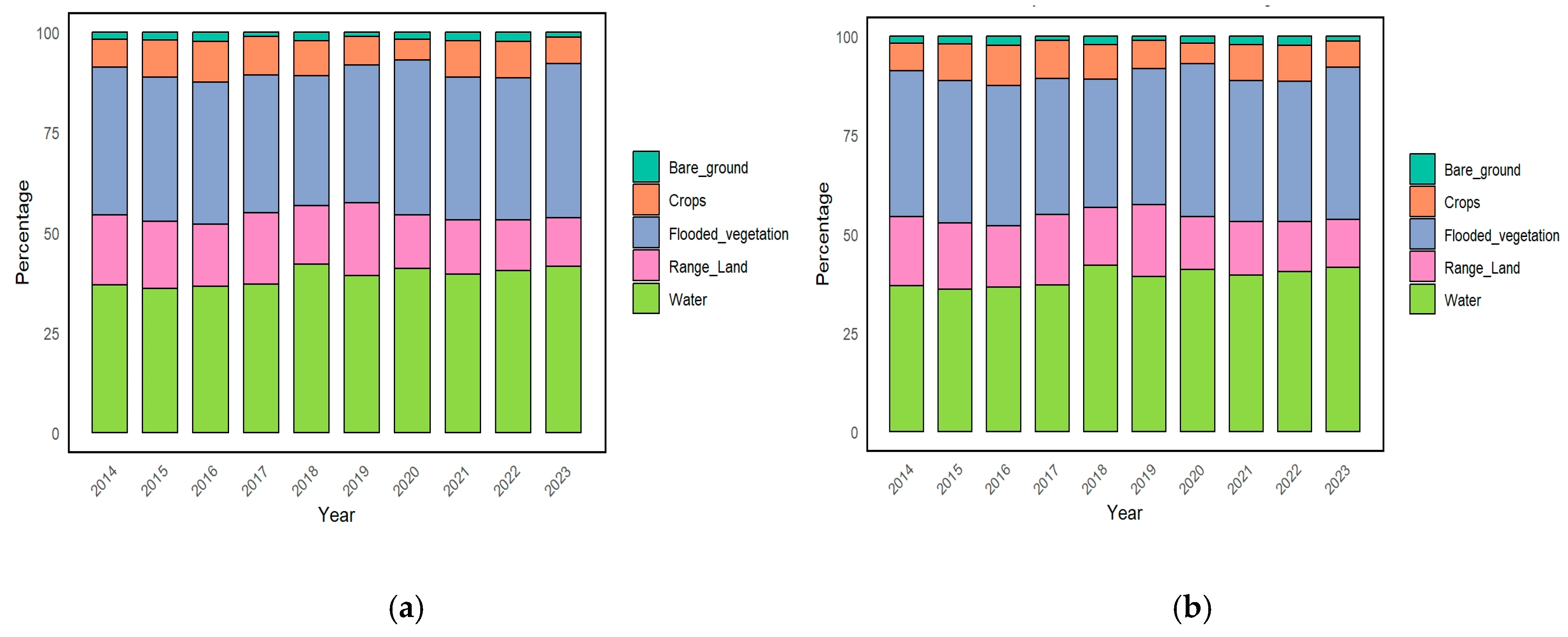

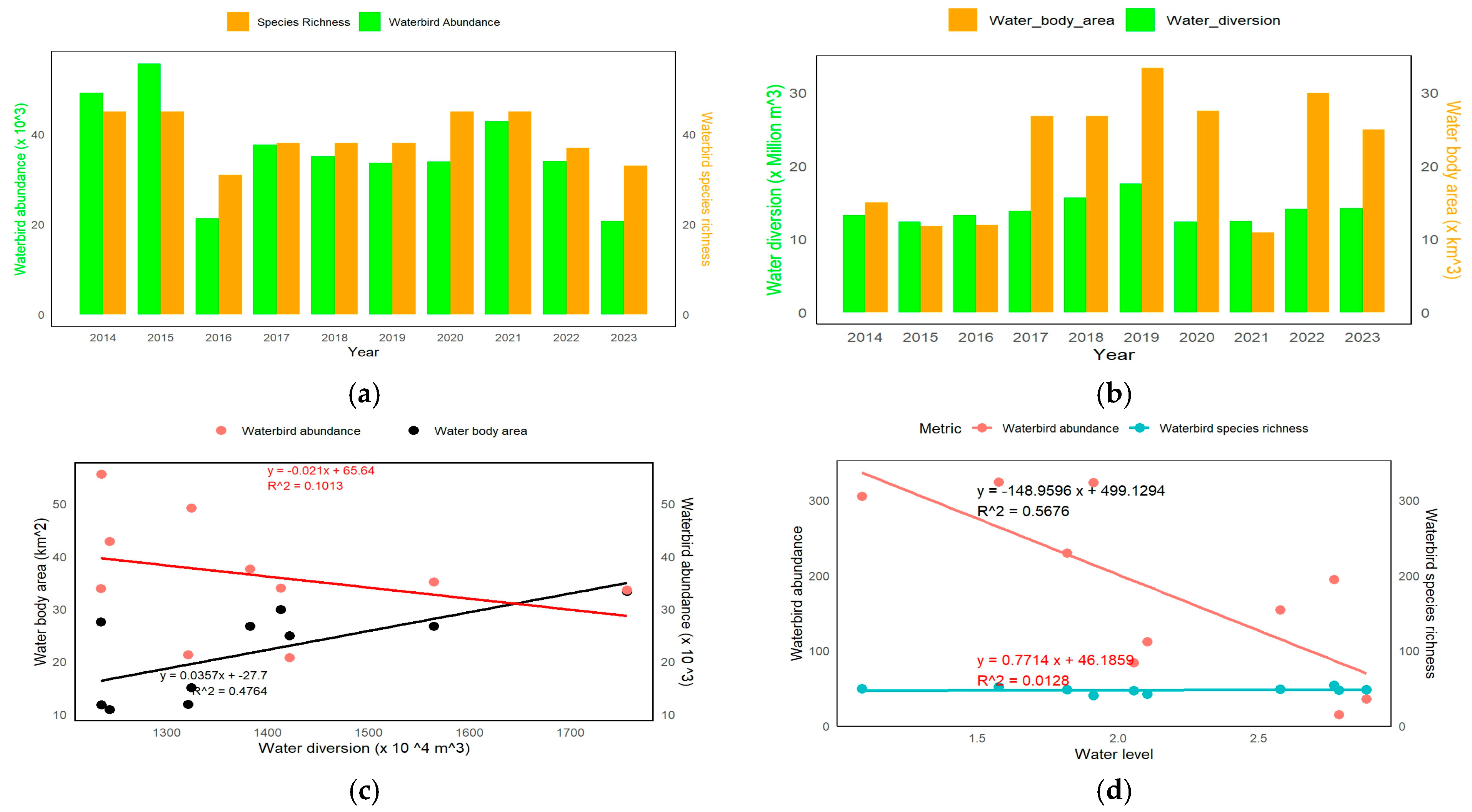
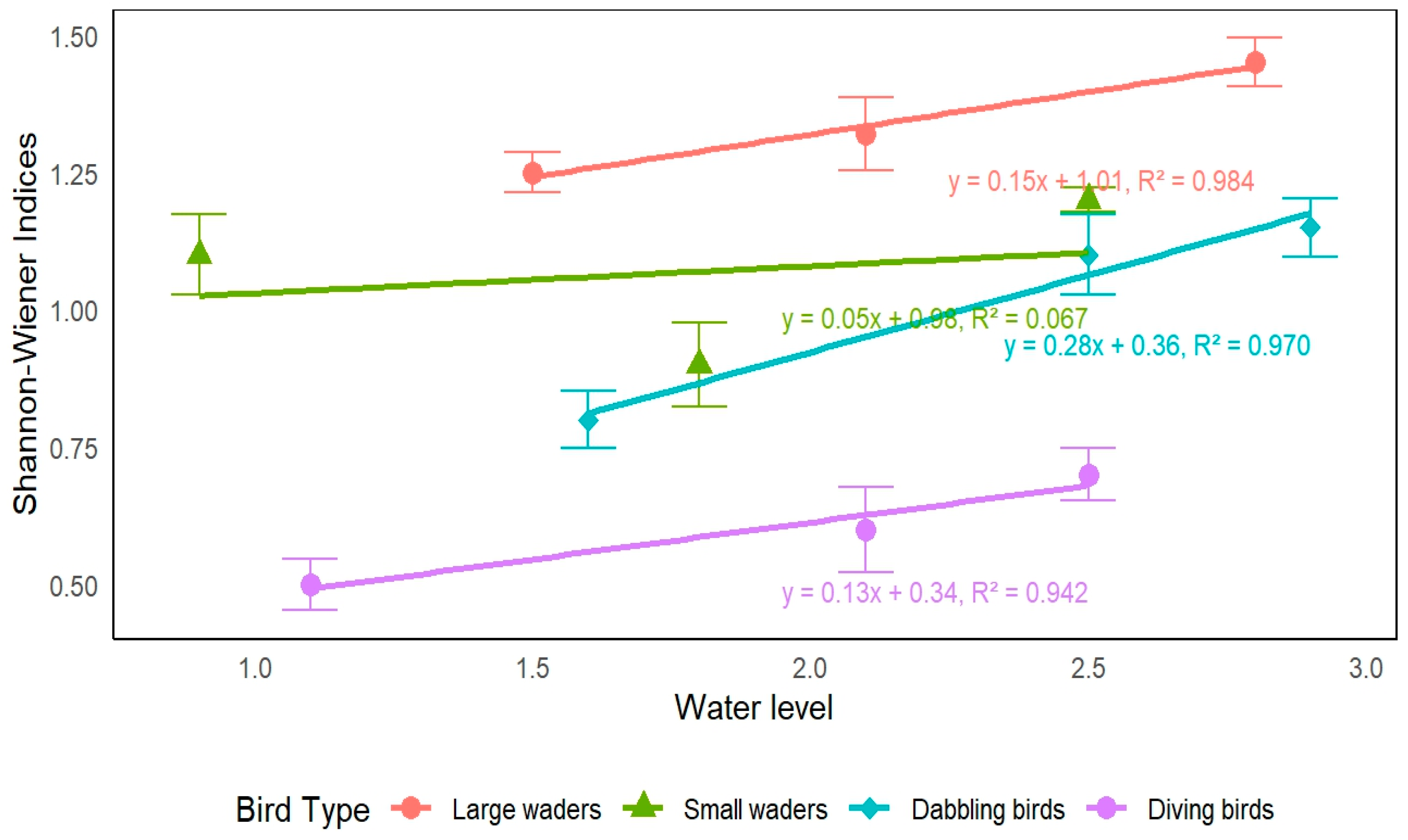
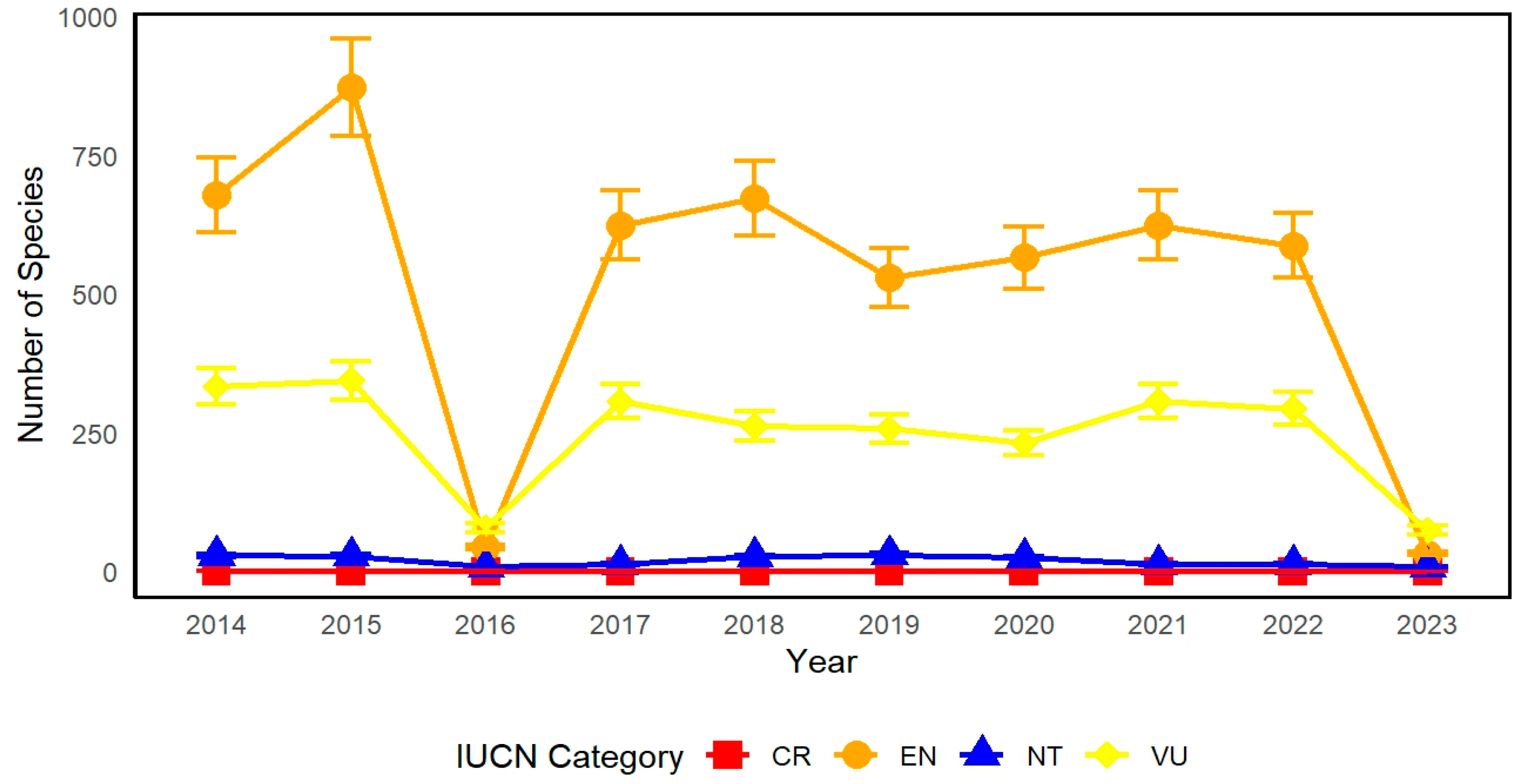
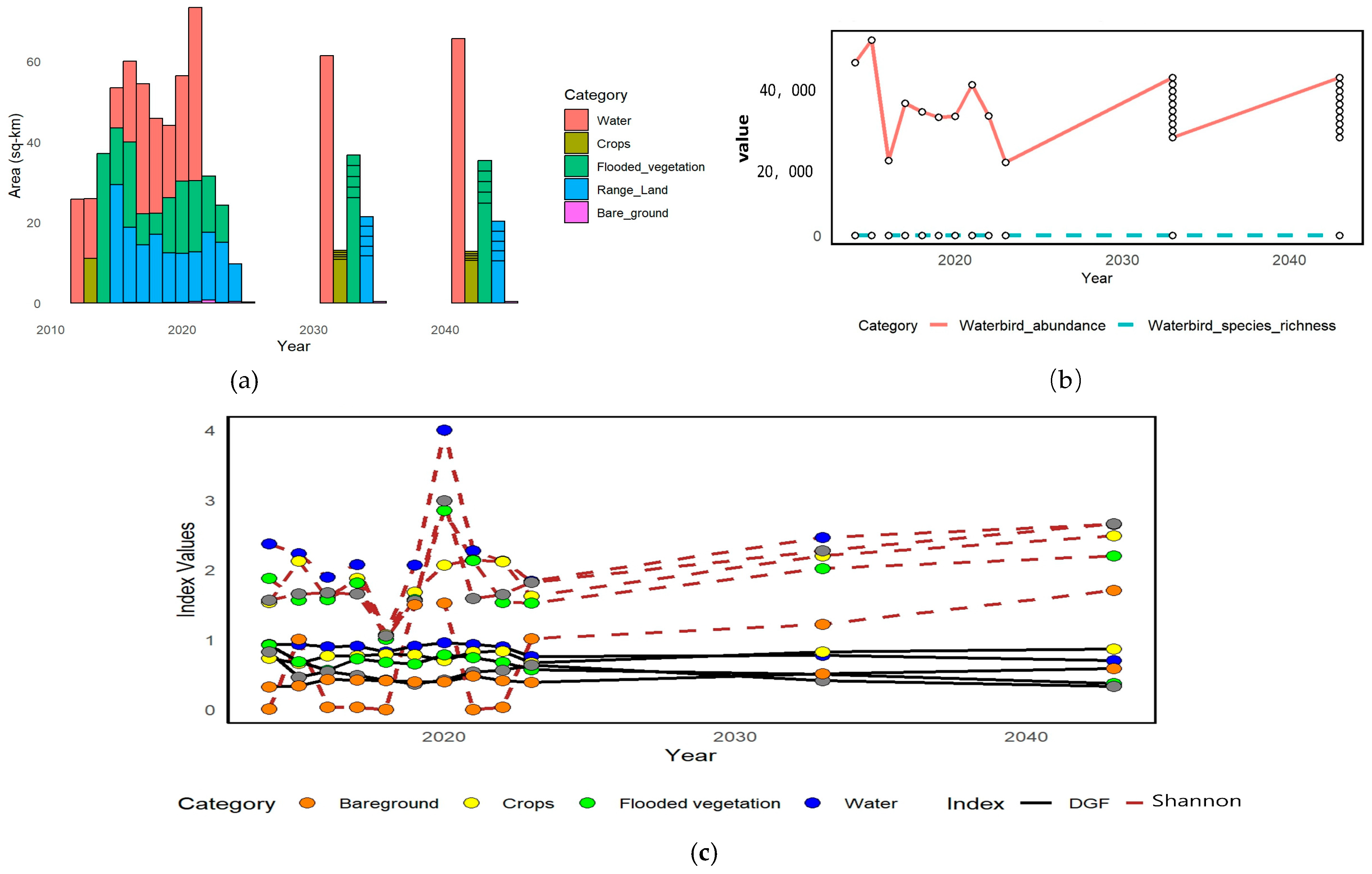
Disclaimer/Publisher’s Note: The statements, opinions and data contained in all publications are solely those of the individual author(s) and contributor(s) and not of MDPI and/or the editor(s). MDPI and/or the editor(s) disclaim responsibility for any injury to people or property resulting from any ideas, methods, instructions or products referred to in the content. |
© 2025 by the authors. Licensee MDPI, Basel, Switzerland. This article is an open access article distributed under the terms and conditions of the Creative Commons Attribution (CC BY) license (https://creativecommons.org/licenses/by/4.0/).
Share and Cite
Marnn, P.; Ali, H.; Jiang, H.; Liu, Y.; Li, Z.; Ahmed, S.; Yang, T.; Li, Z.; He, C. Modeling the Impact of Ecological Restoration on Waterbird Diversity and Habitat Quality in Myanmar’s Moe Yun Gyi Wetland. Biology 2025, 14, 519. https://doi.org/10.3390/biology14050519
Marnn P, Ali H, Jiang H, Liu Y, Li Z, Ahmed S, Yang T, Li Z, He C. Modeling the Impact of Ecological Restoration on Waterbird Diversity and Habitat Quality in Myanmar’s Moe Yun Gyi Wetland. Biology. 2025; 14(5):519. https://doi.org/10.3390/biology14050519
Chicago/Turabian StyleMarnn, Phyoe, Haider Ali, Haibo Jiang, Yang Liu, Ziqi Li, Sarfraz Ahmed, Tao Yang, Ziwei Li, and Chunguang He. 2025. "Modeling the Impact of Ecological Restoration on Waterbird Diversity and Habitat Quality in Myanmar’s Moe Yun Gyi Wetland" Biology 14, no. 5: 519. https://doi.org/10.3390/biology14050519
APA StyleMarnn, P., Ali, H., Jiang, H., Liu, Y., Li, Z., Ahmed, S., Yang, T., Li, Z., & He, C. (2025). Modeling the Impact of Ecological Restoration on Waterbird Diversity and Habitat Quality in Myanmar’s Moe Yun Gyi Wetland. Biology, 14(5), 519. https://doi.org/10.3390/biology14050519





